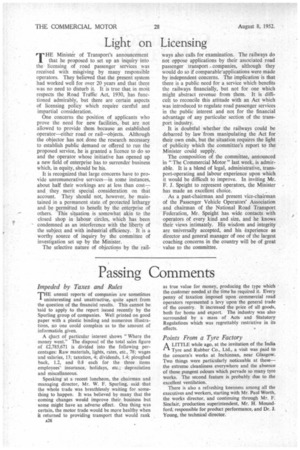Passing Comments
Page 28

Page 29

If you've noticed an error in this article please click here to report it so we can fix it.
THE annual reports of companies are sometimes I uninteresting and unattractive, quite apart from the question of the financial results. This cannot be Said to apply to the report issued recently by the Spurting group of companies. Well printed on good paper with a plastic binding and numerous illustrations, no one could complain as to the amount of informaticin given.
A chart of particular interest shows "Where the money went." The disposal of the total sales figure of 12,785,671 is divided into the following percentages: Raw materials, lights, rates, etc., 78; wages and salaries, 13; taxation, 4; dividends, 1.4; ploughed back, 1.2, and 0.8 each for the three items employees' insurance, holidays, etc.; depreciation and miscellaneous.
Speaking at a recent luncheon, the chairman and managing director, Mr. W. F. Spurting, said that the whole trade was breathlessly waiting for something to happen. It was believed by many that the coming changes would improve their business but some might have an adverse effect. One thing was certain, the motor trade would be more healthy when it returned to providing transport that would rank A26 as true value for money, producing the type which the customer needed at the time he required it. Every penny of taxation imposed upon commercial road operators represented a levy upon the general trade of the country. It increased the price of all goods, both for home and export The industry was also surrounded by a mass of Acts and Statutory Regulations which was regrettably restrictive in its effects.
Points From a Tyre Factory
ALITTLE while ago, at the invitation of the India Tyre and Rubber Co., Ltd., a visit was paid to the concern's works at Inchinnan, near Glasgow. Two things were particularly noticeable at these— the extreme cleanliness everywhere and the absence of those pungent odours which pervade so many tyre works. The second feature is probably due to the excellent ventilation.
There is also a refreshing keenness among all the executives and workers, starting with Mr. Paul Worth, the works director, and continuing through Mr. F. Sinclair, production superintendent, Mr. H. Moundford, responsible for product performance, and Dr. J. Young, the technical director.
In the works nothing is left to chance. The curing of covers, etc., must be performed with meticulous care in respect of temperature arid time. These are controlled by electrical instruments, but no better way of building a tyre has been found than the use of human hands aided by cleverly designed equipment. Tyre design includes such important features as the angle of cut for the cord material. If this be too small, the tyre will grow, if too large there may be wall cracking and hard riding.
Few people realize that in the tread pattern itself the pitch may be varied with the object of breaking up sound waves. This has to be allowed for in building up the moulds. In some instances, the tread pattern is engraved in the solid metal, which requires three weeks' work on each half mould. In another type the pattern is built up in the body of the mould by the insertion of die-cast aluminium segments held by screws, and it is these segments which vary individually to give the pitch alteration. The construction of such a mould may require 30 operations, taking perhaps six weeks. That is one reason why advances in standardization of sizes are welcomed by the tyre makers because each variation means a different mould.
A Wainey Coaching Revival
MODERN coaching has developed largely from the z services run during the coaching revival which took place late in the 19th century. For example, over 100 years ago, Robert Gray ran the Red Rover coach daily from London to Southampton from the Bolt in Tun, Fleet Street. The present owner of this vehicle, Watney Combe Reid and Co., Ltd., is staging a revival of this service and the Coaching Club is loaning nine teams, for there must be eight changes of horses at inns along the route. The Red Rover will start from the Stag Brewery, Victoria, at 7.15 a.m. on August 11. The journey each way will occupy about 12 hours and there will be two complete trips in four days.




















































































